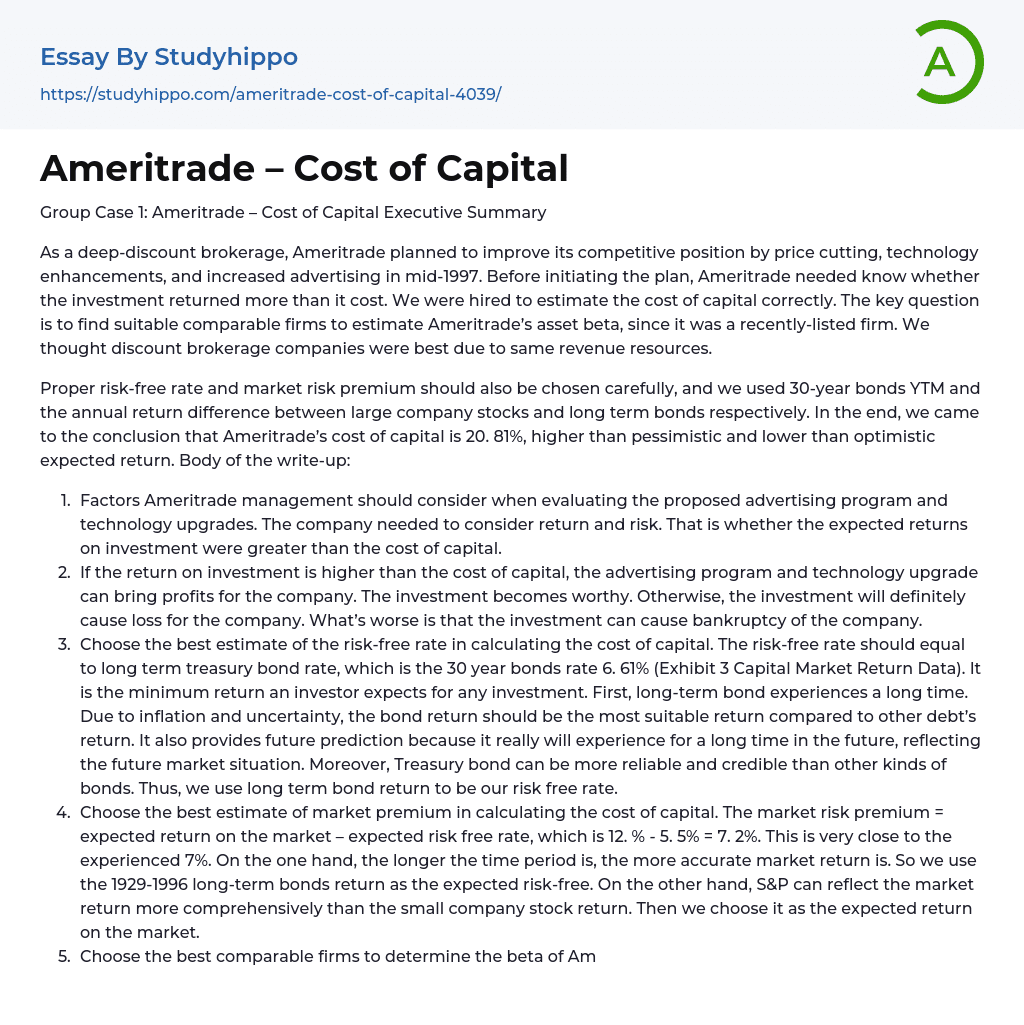Group Case 1: Ameritrade – Cost of Capital Executive Summary
As a deep-discount brokerage, Ameritrade planned to improve its competitive position by price cutting, technology enhancements, and increased advertising in mid-1997. Before initiating the plan, Ameritrade needed know whether the investment returned more than it cost. We were hired to estimate the cost of capital correctly. The key question is to find suitable comparable firms to estimate Ameritrade’s asset beta, since it was a recently-listed firm. We thought discount brokerage companies were best due to same revenue resources.
Proper risk-free rate and market risk premium should also be chosen carefully, and we used 30-year bonds YTM and the annual return difference between large company stocks and long term bonds respectively. In the end, we came to the conclusion that Ameritrade’s cost of capital is 20. 81%, higher than pes
...simistic and lower than optimistic expected return. Body of the write-up:
- Factors Ameritrade management should consider when evaluating the proposed advertising program and technology upgrades. The company needed to consider return and risk. That is whether the expected returns on investment were greater than the cost of capital.
- If the return on investment is higher than the cost of capital, the advertising program and technology upgrade can bring profits for the company. The investment becomes worthy. Otherwise, the investment will definitely cause loss for the company. What’s worse is that the investment can cause bankruptcy of the company.
- Choose the best estimate of the risk-free rate in calculating the cost of capital. The risk-free rate should equal to long term treasury bond rate, which is the 30 year bonds rate 6. 61% (Exhibit 3 Capital Market Return Data). I
is the minimum return an investor expects for any investment. First, long-term bond experiences a long time. Due to inflation and uncertainty, the bond return should be the most suitable return compared to other debt’s return. It also provides future prediction because it really will experience for a long time in the future, reflecting the future market situation. Moreover, Treasury bond can be more reliable and credible than other kinds of bonds. Thus, we use long term bond return to be our risk free rate.
out. Finally, we choose CSC and QRG as the comparable firms to calculate the asset beta of Ameritrade.
further valuation?
- Investing essays
- Asset essays
- Depreciation essays
- Discounted Cash Flow essays
- Foreign Direct Investment essays
- Funds essays
- Internal Rate Of Return essays
- Revenue essays
- Day Trading essays
- Futures Trading essays
- Capital market essays
- Million essays
- Payment essays
- Rate Of Return essays
- Funding essays
- Hedge Fund essays
- Bank essays
- Banking essays
- Corporate Finance essays
- Credit Card essays
- Currency essays
- Debt essays
- Donation essays
- Enron Scandal essays
- Equity essays
- Financial Accounting essays
- Financial Crisis essays
- Financial News essays
- Financial Ratios essays
- Financial Services essays
- Forecasting essays
- Foreign Exchange Market essays
- Free Market essays
- Gold essays
- Investment essays
- Legacy essays
- Loan essays
- Market Segmentation essays
- Money essays
- Personal finance essays
- Purchasing essays
- Retirement essays
- Shareholder essays
- Stock Market essays
- Supply And Demand essays
- Venture Capital essays
- Accounting essays
- Andrew Carnegie essays
- Automation essays
- Business Cycle essays




